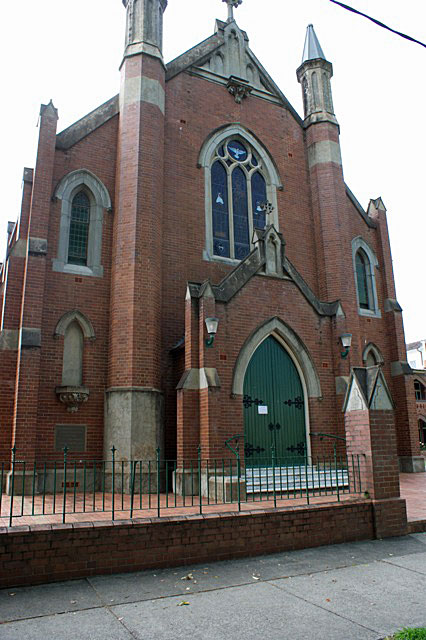
St Mary's Catholic Church, Grafton
[Photograph by Rodney Ford (December 2013)]

St Mary's Catholic Church, Grafton
[Photograph by Rodney Ford (December 2013)]
Historical and Technical Documentation by Geoffrey Cox
© OHTA 2013, 2017 (last updated November 2017)
Following the destruction by fire of the old St Mary's Church in 1913, the foundation stone for a new church was set on 18 January 1914.1 The new St Mary's was completed before the end of the year to the design of architects, Eaton and Bates of Sydney.2 For the new church, an instrument of two manuals and eight speaking stops was ordered from the British Pianoforte Depot Ltd, Sydney.
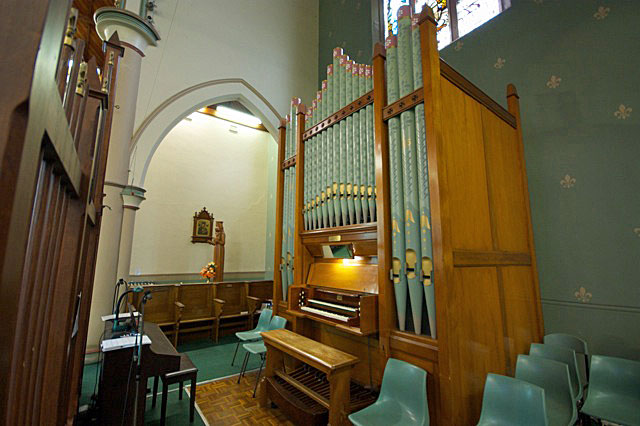
The British Pianoforte Depot Ltd organ of 1914
[Photograph by Rodney Ford (December 2013)]
The British Pianoforte Depot Ltd had commenced trading under this name in Sydney around 1891. From around 1909, the firm began to manufacture organs in Sydney, and these instruments were associated with Frederick Ernst Ladegast, an immigrant German organbuilder who had arrived in Australia in 1883. Ladegast was the son of the famous nineteenth-century German organbuilder, Johann Frederick Ladegast, whose organs were championed by Franz Liszt.3 Trading under the name of the British Pianoforte Depot Ltd, the younger Ladegast built at least nine organs in New South Wales, as well as building and re-building several other organs under his own name.4
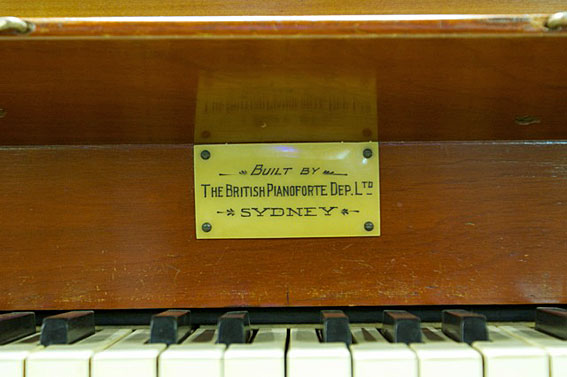
The builder's plate on the organ
[Photograph by Rodney Ford (December 2013)]
The organ for St Mary's was used for a public concert shortly before the official opening and blessing of the church in November 1914:
Opening of the New R.C. Church.
The programme arranged for the reception of the Bishops and visitors at the opening of the new Roman Catholic Church on the last Sunday of the month was definitely fixed up at the last meeting of the Reception Committee during the week. Archbishop Duhig will arrive by the Northern train on Friday afternoon, whilst Bishop O'Connor will come overland by motor car from Armidale. On Friday night an organ recital will be given on the new grand organ in the church by Mr. Massey, the well-known organist of Lismore. On Saturday the Bishops will be "at home" to callers at the Presbytery during the morning and part of the afternoon. On Sunday the opening of the new church will be carried out with great ceremony after 11 o'clock mass. At one o'clock a banquet will be given in the schoolroom. On Monday afternoon a trip up the river has been arranged and at night a meeting will be held to form a branch of the Australian Catholic Federation, at which the president of the Federation, Mr. Carey, will be present to explain and arrange all details. Particulars regarding these functions will be advertised in our columns, and memos will from time to time appear.5
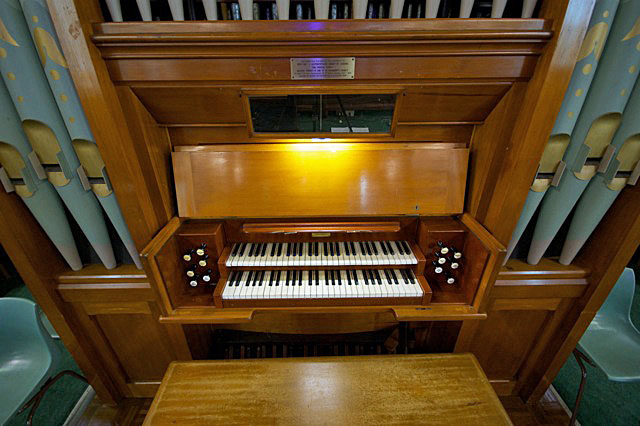
Console of the British Pianoforte Depot Ltd organ
[Photograph by Rodney Ford (December 2013)]
The new organ was described in the local press as follows, whilst being installed in November 1914:
New Pipe Organ.
The new organ now being installed in St. Mary's fine choir loft will be completed in a day or two, and then will be one of the best of its kind in the whole of New South Wales. It is a two manual and pedal instrument with manual compass, double C to A, 58 notes, and the pedals CCC to FF, 30 notes and consists of the following specification:- Great organ, open diapason 8ft., dolce 8ft., stopped diapason, 8ft. harmonic flute 4ft.; swell organ, gamba 8ft., gemshorn 4ft., lieblich gedact 8ft.; pedal organ, bourdon 16ft.; couples, great to pedals, swell to pedals, swell to great, and tremulant to swell. The case is carried out in polished Kauri, with cedar key fittings, and the front show pipes aluminium-coated, with gilt legs. Looking at the organ from the ground floor of the church, the effect is grand. The tone of the instrument is sweet and full, and an opportunity of judging this will be given the public on next Friday night at the recital.6
The opening organ recital on the Friday 27 November was given by Mr Thomas H. Massey, who was organist of St Paul's Presbyterian Church, Lismore, at that time. It also featured vocal and instrumental soloists:
ST. MARY'S ORGAN RECITAL.
. . . Immediately after the addresses a splendid musical programme was begun by Mr. T. H. Massey, who gave with grand effect, and which showed the wonderful capabilities of the new organ, Rossini's overture, "Semiramide," and then a delightful number, " Andantino," by Lemare. Mr. Mario Foldi sang with organ accompaniment in grand voice "Nazareth," "Gio Conda" (Ponchielli), Moskowski's "Seranata," and Dvorak's "Humoreske," all of different styles and clearly giving opportunity to the master hand of the player.
Mrs. Oswald Rienits, whose sweet voice filled the church with unexpected volume, sang delightfully and with perfect enunciation Handel's "Where'er Ye Walk."
"O Sanctissima," by Lux, and a gavotte, "Joy Bells" by Massey, two pieces of contrasts, were given by Mr. Massey, in the first bringing out all its fullness of tone, and in the second the lightness of touch and delicacy [of] movement with much daintiness. Mr. Burton B. Sampson, in the "Air for G String," gave a masterly and effective rendering of this fine violin solo. Mr. G. J. Wellesley sang "Arm, Arm Ye Brave," in which he showed the fine range of his cultured voice. The grandest organ effect which proved Mr. Massey's wonderful skill, was in "The Storm," his own composition, the realistic storm effects being truly wonderful and interwoven with a hymn tune sweet and simple, and the whole ending in a great volume of chords really marvellous. The programme over, Father Lawton thanked the organist, Mr. T. H. Massey, and the artists who had so kindly given their services. He announced that Mr. Massey would play again on Sunday at the ceremonies of the morning, and that the music, under the conductorship of Mr. Donnelly, would be a musical treat never before heard of in Grafton. Every item of the programme was much applauded, and the regret was that it was so short. Lit up by gas, the new church presented a very striking appearance, and words of praise for the new building were heard on all sides. The prelates particularly expressed themselves as delighted at the magnificent church, which they said would be hard to equal outside Sydney. The very large number of people present was a very good omen, and gave one a good idea of what attendances are likely to be at all the other functions within the next few days.7
| GREAT Open Diapason Dolce Stop Diapason Har[monic] Flute SWELL Lieblich Gedackt Gamba Gemshorn PEDAL Bourdon COUPLERS Swell to Great Swell to Pedal Great to Pedal |
8 8 8 4 8 8 4 16 |
Swell tremulant
Compass: 58/30
Mechanical action
Lever swell pedal.8
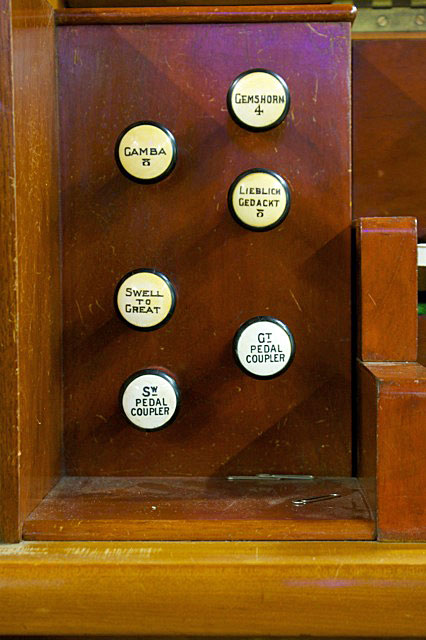
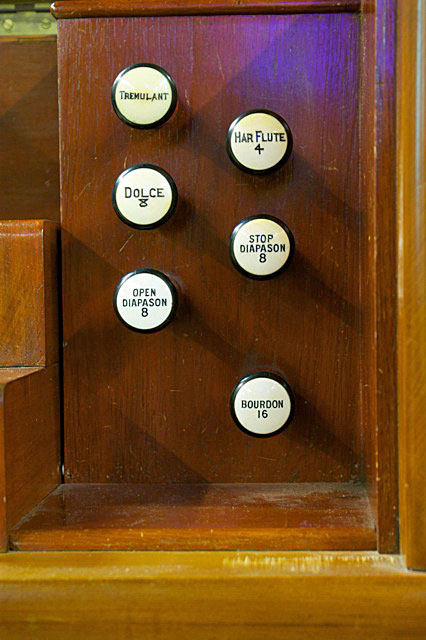
Stop Jambs of the organ
[Photographs by Rodney Ford (December 2013)]
Restored by Peter D.G. Jewkes Pty Ltd in 1995, the organ remains one of the most original examples of the work of the British Pianoforte Depot Ltd. The specification is almost the same as that of the firm's instrument built around the same time for St Mary's Catholic Church, North Sydney, which has since been altered.
In association with major restoration work in the building, the organ was dismantled and stored early in 2017 by Peter D.G. Jewkes Pty Ltd. It was re-erected later in the year in a new position following the completion of a new imitation marble floor.9
1 The Catholic Press (15 January 1914), p. 41.
2 The Sydney Morning Herald (2 December 1913), p. 6; Clarence and Richmond Examiner (Grafton, 23 July 1914), p. 5.
3 Graeme Rushworth, Historic Organs of New South Wales: The Instruments, Their Makers and Players, 1791-1940 (Sydney: Hale & Iremonger, 1988), pp. 149-156.
4 John Maidment, Gazetteer of New South Wales Pipe Organs (Melbourne: Society of Organists, 1981).
5 Clarence and Richmond Examiner (Grafton, 7 November 1914), p. 4.
6 Clarence and Richmond Examiner (Grafton, 21 November 1914), p. 4.
7 Clarence and Richmond Examiner (Grafton, 28 November 1914), p. 2.
8 Rushworth, op. cit., p. 155.
9 Ian D. Brown and Associates Newsletter (December 2017), pp. 3-4, rpt. in The Sydney Organ Journal, vol. 49, no. 1 (Summer 2017-18), p. 45.